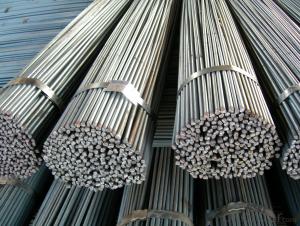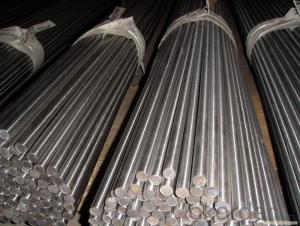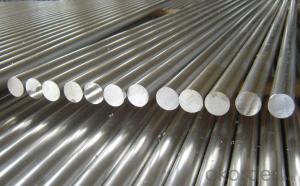High quality round bar 5-100
- Loading Port:
- China Main Port
- Payment Terms:
- TT OR LC
- Min Order Qty:
- -
- Supply Capability:
- -
OKorder Service Pledge
OKorder Financial Service
You Might Also Like
Product Description:
High Quality Round Bar Details:
| Minimum Order Quantity: | 25 Tons | Unit: | m.t. | Loading Port: | Tianjin |
| Supply Ability: | 500 Tons Per Day | Payment Terms: | TT or L/C | | |
Product Description:
Specifications of High Quality Round Bar
1. Grade: GB, JIS, ASTM, EN
2. Grade: Q235, SS400, A36, S235JR
3. Diameter and mass: As below
Diameter | Mass | Diameter | Mass | Diameter | Mass |
(mm) | (kg/m) | (mm) | (kg/m) | (mm) | (kg/m) |
6 | 0.22 | 22 | 2.98 | 53 | 17.30 |
7 | 0.30 | 24 | 3.55 | 56 | 19.30 |
8 | 0.40 | 25 | 3.85 | 60 | 22.20 |
9 | 0.50 | 26 | 4.17 | 63 | 24.50 |
10 | 0.62 | 28 | 4.83 | 65 | 26.00 |
11 | 0.75 | 30 | 5.55 | 70 | 30.20 |
12 | 0.89 | 32 | 6.31 | 75 | 34.70 |
13 | 1.04 | 34 | 7.13 | 80 | 39.50 |
14 | 1.21 | 36 | 7.99 | 85 | 44.50 |
15 | 1.39 | 38 | 8.90 | 90 | 49.90 |
16 | 1.58 | 40 | 9.86 | 95 | 55.60 |
17 | 1.78 | 42 | 10.90 | 100 | 61.70 |
18 | 2.00 | 45 | 12.50 | 120 | 88.85 |
19 | 2.23 | 48 | 14.20 | 140 | 120.93 |
20 | 2.47 | 50 | 15.40 | 150 | 138.82 |
4. Material: Mild Steel
5. Heat treatment of high quality steel:
Fire: Isothermal annealing temperature is 800 ~ 880 °C, with 10 ~ 20 °C, the furnace cooling to about 600 °C, hardness above HB269.
Preheat temperature: 730-730 °C
Quenching temperature: 1190-1210 °C
Tempering temperature: 540-595 °C
Cold drawn, hardness 285 HBS
Cold drawn after annealing condition, hardness 277 HBS
Quenching methods: oil quenching, air cooling or salt bath quenching
Usage and Applications of High Quality Round Bar
1) Suitable for making various strong cutting tool abrasion resistance, impact resistance.
2) Used to produce all kinds of high hard and super hard saw blade, drill, tap, broach, gear hob and various kinds of milling cutter.
3) Used for advanced punching die, screw die, and the toughness and complicated shape of the punch, etc.
4) Is used for cold forging die and drawing mode, etc.
5) Recommended watchcase factory, screw factory and other cold stamping products industry use.
Packaging & Delivery of High Quality Round Bar
Packaging Detail: All goods are packed in bundle with steel strips and shipped by break bulk vessel or container (depend on target market and different ports)
Delivery Detail: 45 days
Trade terms: FOB, CFR, CIF
MOQ: 25 tons per specification; we can negotiate the quantity if the specification is normal or we have stock of one specification.
Weight: Theprice invoicing on theoretical weight basis or actual weight basis depends on customer’s request.
Shipment: The shipment of bulk break or container is depends on customer’s request and the situation of the port of destination.
Documents given: Full set of original clean on board bill of lading; Original signed commercial invoice; Original packing list; Policy of insurance; Certificate of origin and what the target market needs.
Production Flow of High Quality Round Bar
The common processes are preheated forging quenching, dual refinement solution process, cooling quenching and isothermal quenching. We use heat treatment for dual refinement solution process. The main measures process is high temperature solution and refinement cycle. High temperature solution can improve the carbide morphology and particle size. The aim is to make the loop refinement ultrafine austenite grains
- Q:What is the tolerance for diameter in steel round bars?
- The tolerance for diameter in steel round bars can vary depending on the specific standards and requirements set by the manufacturer or industry. Generally, the tolerance for diameter in steel round bars is specified within a certain range to ensure the desired level of precision and consistency in the dimensions of the bars. This tolerance is usually expressed as a plus or minus value, indicating the acceptable deviation from the specified diameter. It is important to check the relevant industry standards or consult with the manufacturer to determine the specific tolerance for diameter in steel round bars, as it can differ based on the intended application and the manufacturing process used.
- Q:20# difference between round bar and A3 round bar, can they be used separately?
- The first floor of the answer is lame, 20 is a low carbon steel, low carbon steel is A3, and the two carbon content are equivalent, both mechanical properties are equivalent, but they are not the same, the 20 steel is high quality carbon steel, carbon structural steel is A3, not to see the difference. 20 steel better quality, chemical composition, impurity content control are better, and A3 to casually, so if you only occasionally used, that is no problem, if often use, it is a better consistency of 20 steel
- Q:What are the different types of steel round bar alloys used in the automotive industry?
- In the automotive industry, some of the commonly used steel round bar alloys include carbon steel, alloy steel, stainless steel, and tool steel. Carbon steel is widely used due to its affordability and high strength. Alloy steel, on the other hand, is known for its enhanced mechanical properties and resistance to wear and tear. Stainless steel is popular for its corrosion resistance, making it suitable for parts exposed to harsh environments. Lastly, tool steel is utilized for its exceptional hardness and ability to withstand high temperatures, often used in the production of cutting and shaping tools for automotive manufacturing.
- Q:What are the specifications and standards for steel round bars?
- The specifications and standards for steel round bars vary depending on the intended use and industry requirements. However, there are some general specifications and standards that apply to most steel round bars. Firstly, the dimensions of steel round bars are typically specified in terms of diameter, length, and tolerance levels. The diameter can range from a few millimeters to several inches, and the length can vary as per the customer's needs. The tolerance levels indicate the allowable deviation from the specified dimensions and ensure the bars meet the desired accuracy and consistency. In terms of material composition, steel round bars are predominantly made from carbon steel, alloy steel, or stainless steel. The specific grade and composition of the steel will depend on the application, such as structural, construction, automotive, or aerospace. These grades are established by various organizations, such as the American Society for Testing and Materials (ASTM) or the International Organization for Standardization (ISO), and they define the chemical composition, mechanical properties, and other characteristics of the steel. Regarding mechanical properties, steel round bars must meet certain standards to ensure their strength, ductility, and resilience. These properties include tensile strength, yield strength, elongation, hardness, impact resistance, and more. The standards for these mechanical properties are specified by relevant organizations like ASTM or ISO, and they provide guidelines for manufacturers and users to ensure the bars are suitable for their intended applications. Surface finish is another important aspect of steel round bars. The standard surface finish options include black, peeled, ground, polished, or chrome-plated, among others. These finishes affect the appearance, corrosion resistance, and ability to withstand wear and tear. Furthermore, steel round bars may need to adhere to specific standards for heat treatment, such as annealing, quenching, or tempering, to enhance their mechanical properties or improve their machinability. Overall, the specifications and standards for steel round bars encompass dimensions, material composition, mechanical properties, surface finish, and heat treatment requirements. These standards ensure that steel round bars meet the necessary quality, performance, and safety criteria for their designated applications. It is crucial for manufacturers, suppliers, and end-users to be aware of these specifications and standards to ensure the appropriate selection and use of steel round bars.
- Q:What is the difference between a solid steel round bar and a hollow steel round bar?
- A solid steel round bar is a cylindrical metal rod that has a uniform diameter throughout its entire length. It is made of solid steel, meaning it does not have any hollow or empty space inside. On the other hand, a hollow steel round bar also has a cylindrical shape but contains a hollow or empty space within its center. This hollow space can vary in size, depending on the specific design and purpose of the hollow round bar. The main difference between the two lies in their structural integrity and weight-bearing capacity. A solid steel round bar offers greater strength and stability compared to a hollow steel round bar. This is because the solid bar is made of a continuous steel material, making it more resistant to bending, twisting, or deforming under pressure. It is commonly used in applications where high strength and durability are required, such as construction, engineering, and manufacturing industries. In contrast, a hollow steel round bar may have reduced strength and load-bearing capacity due to the presence of the hollow space within. However, the hollow design provides certain advantages in terms of weight, cost, and flexibility. The hollow space allows for a lighter overall weight of the bar, making it more suitable for applications where weight is a critical factor, such as aerospace or automotive industries. Additionally, the hollow space can be utilized for various purposes, such as passing through electrical wires or fluids, providing a channel for ventilation, or even reducing material costs by using less steel. Ultimately, the choice between a solid steel round bar and a hollow steel round bar depends on the specific requirements of the application. If strength and stability are paramount, a solid bar would be the preferred choice. Conversely, if weight reduction, cost-efficiency, or additional functionality is desired, a hollow bar may be more suitable.
- Q:Can steel round bars be used for making exercise equipment?
- Steel round bars are a viable option for manufacturing exercise equipment due to their durability and strength. These bars are renowned for their ability to withstand heavy loads and provide stability during workouts, making them suitable for constructing various types of fitness equipment. Weightlifting bars, dumbbells, barbells, and other exercise equipment that require reliable materials can be created using steel round bars. Moreover, these bars can be easily machined, welded, and shaped into different forms, allowing for customization and versatility in exercise equipment design. As a result, steel round bars are favored by gym equipment manufacturers and fitness enthusiasts alike.
- Q:What is the difference between a bright and a rough turned steel round bar?
- A bright turned steel round bar refers to a steel bar that has undergone a finishing process, resulting in a smooth and polished surface. On the other hand, a rough turned steel round bar has a more textured surface due to minimal finishing, giving it a rougher appearance.
- Q:Are steel round bars available in different shapes?
- Typically, steel round bars are solely obtainable in a cylindrical or circular form. The designation "round bar" specifically pertains to the steel's shape, generally a solid cylindrical unit. Nevertheless, alternative steel bars are accessible in diverse shapes, such as square bars, flat bars, or hexagonal bars, presenting distinct attributes and applications.
- Q:What are the common sizes and dimensions of steel round bars?
- Steel round bars come in a variety of sizes and dimensions to cater to different applications and requirements. The most common sizes and dimensions of steel round bars include diameters ranging from 1/4 inch to 24 inches. These diameters correspond to the nominal size of the round bar, which represents the approximate measurement of the bar's cross-sectional diameter. In terms of dimensions, steel round bars are typically available in standard lengths of 20 feet or 6 meters. However, custom lengths can be produced upon request. The length of the round bar is crucial as it determines the amount of material available for cutting, shaping, and fabrication. Additionally, the weight of steel round bars can vary depending on their size. Steel is typically measured by its weight per unit length, commonly expressed in pounds per foot or kilograms per meter. The weight of a steel round bar is influenced by the diameter, length, and specific type of steel used. It is worth noting that the sizes and dimensions mentioned above are standard in the industry, but there may be variations depending on the specific manufacturer or supplier. Therefore, it is always advisable to consult the manufacturer's catalog or contact them directly to obtain accurate and up-to-date information on the sizes and dimensions of steel round bars they offer.
- Q:How do you check the quality of a steel round bar?
- To check the quality of a steel round bar, several factors need to be considered. Firstly, it is important to assess the bar's dimensions. This involves measuring its diameter, length, and straightness. Any deviation from the specified dimensions could indicate a lower quality bar. Next, the surface condition of the steel round bar should be inspected. It should be free from any visible defects, such as cracks, pits, or surface irregularities. Additionally, the bar's surface should be smooth and devoid of any significant roughness or burrs. Furthermore, the chemical composition of the steel round bar must be examined. This can be determined through spectroscopic analysis or other testing methods. The composition should meet the required standards and specifications, as any deviations can affect the bar's strength and durability. Another crucial aspect to consider is the mechanical properties of the steel round bar. This involves testing its tensile strength, yield strength, and elongation. These tests can be conducted using specialized machines to ensure that the bar meets the necessary strength requirements. Additionally, the steel round bar can be subjected to non-destructive testing methods, such as ultrasonic testing or magnetic particle inspection. These techniques help identify any internal or surface defects that may impact the bar's quality. Furthermore, it is essential to verify the bar's compliance with industry standards and certifications. This includes checking if the steel round bar meets the specifications set by organizations such as ASTM International or ISO. Lastly, it is advisable to consult with reputable suppliers or manufacturers who have a proven track record in producing high-quality steel round bars. They can provide documentation, certifications, and test reports to validate the quality of their products. In summary, evaluating the dimensions, surface condition, chemical composition, mechanical properties, compliance with standards, and supplier's reputation are key steps to check the quality of a steel round bar. By thoroughly examining these factors, one can ensure the reliability and performance of the steel round bar for their intended applications.
1. Manufacturer Overview |
|
|---|---|
| Location | |
| Year Established | |
| Annual Output Value | |
| Main Markets | |
| Company Certifications | |
2. Manufacturer Certificates |
|
|---|---|
| a) Certification Name | |
| Range | |
| Reference | |
| Validity Period | |
3. Manufacturer Capability |
|
|---|---|
| a)Trade Capacity | |
| Nearest Port | |
| Export Percentage | |
| No.of Employees in Trade Department | |
| Language Spoken: | |
| b)Factory Information | |
| Factory Size: | |
| No. of Production Lines | |
| Contract Manufacturing | |
| Product Price Range | |
Send your message to us
High quality round bar 5-100
- Loading Port:
- China Main Port
- Payment Terms:
- TT OR LC
- Min Order Qty:
- -
- Supply Capability:
- -
OKorder Service Pledge
OKorder Financial Service
Similar products
New products
Hot products
Related keywords































